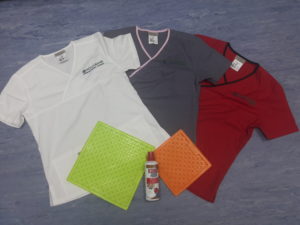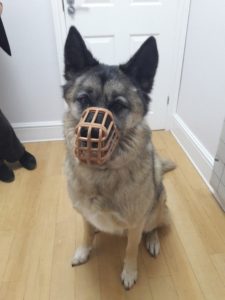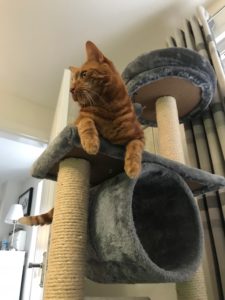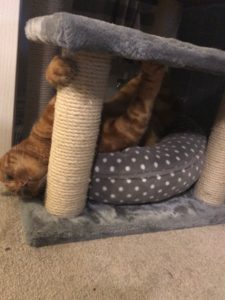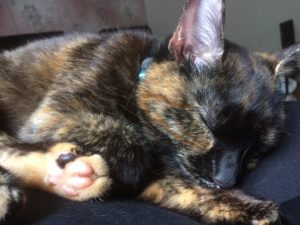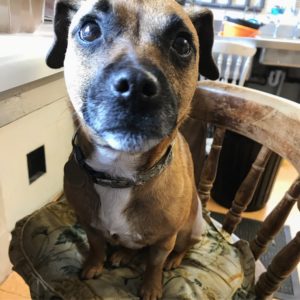 Gorgeous Gwen was suffering from recurrent lameness in her left hind. As she was such a brave sweet girl it was very hard initially to localise where she was painful. She seemed to respond to rest and pain relief so we persevered with this. However, with time, the lameness recurred more frequently and Gwen became harder to keep comfy.
Gorgeous Gwen was suffering from recurrent lameness in her left hind. As she was such a brave sweet girl it was very hard initially to localise where she was painful. She seemed to respond to rest and pain relief so we persevered with this. However, with time, the lameness recurred more frequently and Gwen became harder to keep comfy.
As the frequency and severity of Gwen’s lameness progressed it became more obvious that Gwen was painful in her left hip. Given her history and relatively young age we decided it was best to take some x-rays in case there was something more specific we could be doing. It is also helpful to re-examine patients when they are more relaxed; this is sometimes the only time we can feel an unstable knee or a luxating knee cap. These were both potential differential diagnoses or complicating factors we wanted to rule in or out for Gwen.
 Gwen’s X-rays revealed a severely abnormal left hip joint. This may be related to abnormal development and can be referred to as hip dysplasia. Young small dogs can also suffer from a type of developmental disease called Legg-calve-perthe’s disease; this is where poor blood supply to the ball of the joint results in degeneration of the cartilage and bone. With any abnormal joint there is a risk of secondary osteoarthritis which was evident by the uneven and bumpy surface of her ball and socket joint.
Gwen’s X-rays revealed a severely abnormal left hip joint. This may be related to abnormal development and can be referred to as hip dysplasia. Young small dogs can also suffer from a type of developmental disease called Legg-calve-perthe’s disease; this is where poor blood supply to the ball of the joint results in degeneration of the cartilage and bone. With any abnormal joint there is a risk of secondary osteoarthritis which was evident by the uneven and bumpy surface of her ball and socket joint.
Regardless of the exact cause, in such cases where pain cannot be adequately managed with oral pain relief we choose to perform a surgery to give a better quality of life. We decided this was the case for Gwen.
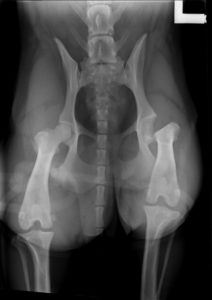 The surgery is called a femoral head and neck excision. This involves removing the abnormal ball of the hip’s ball and socket joint so that the remaining flat end can fuse with the hip joint. Although the joint will never function as a ‘normal’ joint and cannot have the same range of motion, the joint is no longer painful and so allows a significantly better long term outcome. The post op radiographs hopefully make this procedure clearer.
The surgery is called a femoral head and neck excision. This involves removing the abnormal ball of the hip’s ball and socket joint so that the remaining flat end can fuse with the hip joint. Although the joint will never function as a ‘normal’ joint and cannot have the same range of motion, the joint is no longer painful and so allows a significantly better long term outcome. The post op radiographs hopefully make this procedure clearer.
The ‘new joint’ is stabilised by the development of new fibrous tissue, a process which her own body will take care of itself. However, in order to encourage appropriate fibrous connections and mobility, early and controlled return to exercise is needed. Physiotherapy and hydrotherapy are also carefully utilised.
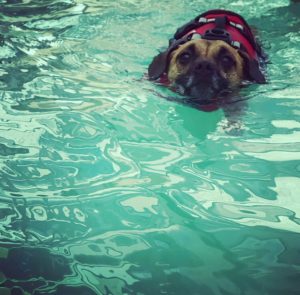 Leonie, one of our registered veterinary nurses led Gwen’s physiotherapy sessions checking up on her weekly to ensure the right progress was being made. Gwen’s lovely owner was dedicated and took her to hydrotherapy lessons too. Not being a swimmer, Gwen actually really took to and loved her hydrotherapy!
Leonie, one of our registered veterinary nurses led Gwen’s physiotherapy sessions checking up on her weekly to ensure the right progress was being made. Gwen’s lovely owner was dedicated and took her to hydrotherapy lessons too. Not being a swimmer, Gwen actually really took to and loved her hydrotherapy!
Gwen’s recovery took time but she did brilliantly, she was a happy and comfy little girl and we managed to completely stop all pain relief.
Recently she has had a little flare up of lameness in that leg. Inevitably she will be at risk of future osteoarthritis and she may well upset the joint intermittently being a bouncy young terrier! We can manage the leg with pain relief again as and when we need to but at least Gwen has been given the best opportunity to keep that limb pain free and manageable for as long as possible.



